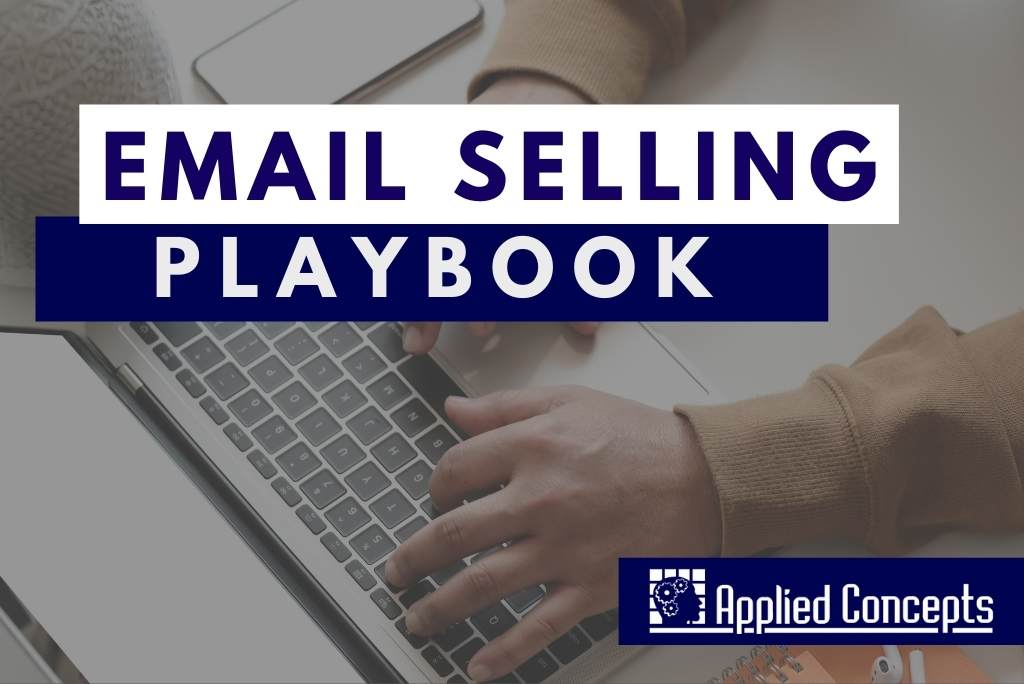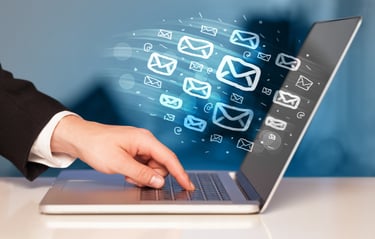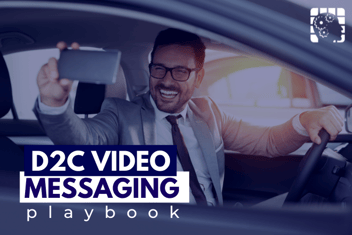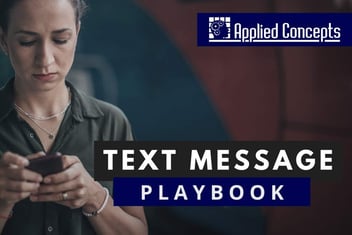Email Selling Playbook


In the age of texting and chat apps, where does a good ole fashioned email fit into the communication mix? The answer is — everywhere! Done right, email can be a great tool to bolster sales and maintain long-term relationship! Done wrong, you may find yourself ignored, deleted, or worse . . . flagged as spam.
Quick Links
- Getting Situated
- Master the Basics of Nurturing Emails
- Objective
- First Thing First, Second Thing Second
- Effective Subject Lines for High Open Rates
- Calls to Action
- Be Thoughtful
- Focus on Recipient
- Don't Undermine your Professionalism
- Avoid Restraining Orders
- Attachments v. No Attachments
- Length
- Time of Day
- Final Check
- Method of Sending
- How Can We Help?
Getting Situated
There are 2 important types of emails that support your sales process – Lead Generation Emails and Lead Nurturing Emails.
- Lead Generation - These emails include cold outreach emails, marketing emails, automated emails, and other emails that cast a wide net. In the case of cold outreach and marketing emails, the goal is to provide information about your product to a targeted customer base with the goal of getting the recipient to respond or react (and thus enter into your sales funnel). In the case of automated emails, they are generally triggered by certain events, such as a consumer submitting their information on a form on your website or completing their credit application. These emails are often sent via a software and/or marketing automation platform.
- Lead Nurturing - These emails are individual and direct communications with a customer who is working their way through their buying journey. The intent is to support and guide them as a trusted advisor, with the ultimate goal of making the sale. Instances where you would use email in the buying journey include:
- Sending additional information such as a spec sheet or product video
- As a secondary follow up to a voicemail that you left
- A softer “check in” point, where perhaps phone and text have been ineffective
- A thank you note in appreciation for a recent purchase.
In this Playbook, we will focus on the emails you send to customers every single day - the Lead Nurturing email.
Mastering Lead Nurturing Emails
Objective of Lead Nurturing Emails
Similar to text messaging, the objective of an email is to advance the ball to the next interaction and, in the process, build a trusting relationship across multiple touch-points and multiple communication channels. [Read our Text Message Playbook]
Non-Invasive Follow-Up
While the phone should always be your initial go-to when following up with a customer, email can be a perfect secondary tool to nudge the customer, especially after you leave a voicemail or haven't heard from the customer in a couple of days.
Email also allows you to supplement your prior communication and voicemails with a bit of additional, enticing information and gives the customer an alternative way to contact you.
As discussed in our Text Messaging Playbook, a poorly executed text message follow-up can to be considered invasive and impatient. Email is a much less intrusive way to keep the communication pipeline open.
Additional Information
Email is often the most effective way to send your customer additional information, such as videos, PDFs, and images, due to the varying file sizes and types. Customers can download and preview on the most appropriate device, including their cell phone, tablet or computer.
What to Avoid
Avoid getting too far in the weeds. For example, do not negotiate price and/or terms, hard-close, or discuss sensitive/complex topics.
Also avoid long, drawn-out conversations via email. For example, an email conversation consisting of 5+ emails is likely too drawn out.
First Thing First, Second Thing Second
Sending an effective email can be separated into two distinct steps. Tackle each one separately.
- Open The Email - First, you need them to open the email. Part of this is out of your control. The consumer just may not be interested or may not check their email very often. But there is one thing that you can control, and that's the subject line. Studies and analyses agree that an effective subject line can really improve your open rate. We dive into subject lines in the next section below.
- Act / Respond to the Email - Next, you need to them to click on the link you sent, respond to your question, look at the pictures you sent, or otherwise take some action. Again, control what you can. The best practices below will help you create email content that will drive your click rate and/or response rate.
1. Effective Subject Lines for Higher Open Rates
There are a number of best practices to write an effective subject line, which can ensure the customer will see and read your message.
- Keep the subject line to between 6-10 words.
- Eliminate filler words.
- Don’t be afraid to tell the recipient what is inside; nondescript, vague subject lines introduce an element of skepticism and mistrust that will lower your open rate.
- Personalize the subject whenever possible by using a recipient's name, mentioning someone they know, or referring to a personal tidbit about them to establish a connection.
- "Photos of the SUV you looked at"
- “John – thanks for stopping by!”
- “Here is the info we discussed today”
Ineffective examples include:
- "Following up"
- "Checking in"
- "Pictures"
2. Calls to Action for Higher Response Rates
Be very clear about next steps or follow-up activities so the consumer knows what to do. If you want them to:
- Review an attachment or click a link - Explain what you have sent and how they can access it. ("Please click the link below to view the video walk-around of the vehicle we discussed today.")
- Set an appointment - Suggest available dates and times and ask them to confirm. If those times don't work, ask them to recommend alternative
- Reply to your message - Ask them to respond by a set date and give clear guidelines as to what that response should to look like if they want to move forward.
Make it easy for the reader to take the next step if they choose to do so. Make the call to action a separate paragraph. Avoid burying it in the middle of a paragraph or too far down the page so that the read needs to scroll in order to see it.
Be Thoughtful
Whether you are using templated emails or sending one-off emails, it should go without saying that you need to be thoughtful about what you actually include in the email. Unfortunately, our mystery shopping demonstrates that there's often a lack of thoughtfulness, and reps just fire off an email without much thought.
They contend, "Stop overthinking it, just send the email. This isn't rocket science." But consider this: over the course of the year, how many emails do you send? Hundreds? Thousands? The impact of increasing your response rate from 20% to 25% would have a huge impact on your pocket and the bottom line of your dealership. Give your emails the thoughtfulness that they deserve. You're only doing yourself a disservice if you don't.
Focus on the Recipient
The purpose of the email is not to talk about you – it’s to talk about them. They have a need or problem and you are there to help. Make sure your content addresses their needs and offers your expertise as the most effective solution.
Professionalism
In our Mystery Shopping, it's shocking how often we receive unprofessional, spammy emails that are more likely to result in a restraining order than a sale.
- Every message should look professional, be on brand and be easy to read and understand.
- Use common language. People respond to people, not robots. Make sure you use words and phrases that sound normal, relatable and conversational
- In almost all cases, stick to the default font types (Arial, Calibri, Times New Roman), font sizes (11-12 pt), and font color (black).
- Use spelling check and grammar check
- Consider installing grammarly.com to put the polishing touches on your message
Don't Appear (or Be) Spammy
If it looks, feels, and sounds like spam, then it is spam, and the spam filters and your recipients will treat you like spam. It's astonishing how often the basic rules below are violated.
- Avoid CAPITALIZING, bolding, underlining, coloring, highlighting what you think are the important parts of your email. It creates a false, hyperactive sense of urgency around your message that only undermines your professionalism and makes you seem like you're peddling trinkets on an infomercial at 2:00am. If the message is that important, then perhaps email is not the right medium to be communicating it.
- Avoid using “spammy” words like “Free” and “Promo” that could send you straight to the Junk folder.
- Ensure any links are from reputable domains and test that they work
- Keep the text-to-image ratio balanced.
Avoid Restraining Orders
Sending too many emails in quick succession or following up too quickly to an inquiry can sour a relationship very quickly. Aim to find a balance between persistence and annoyance. Emails should act as a support channel adding value to the journey, not be a source of agitation.
Attachments v. No Attachments
The general rule of thumb is to avoid attachments in email. That said, if you have already established a relationship with the customer, and they are expecting something from you, then by all means attach away! Within reason of course - always be mindful of file format and size, using PDF for documents and .jpg for photos whenever possible.
As an alternative to attachments, send a link instead, especially when it's a big file size, like is the case with videos.
Length
The paragraph you are reading right now is 5 sentences, which is about the sweet spot for email length. Never exceed 8 sentences. Keep your message to the point by directly answering their question or providing the requested information. Close with an effective call to action to advance the ball to the next appropriate stage. Don't forget to include your contact information should they decide to follow up via another method!
Keep in mind that many people will be reading your email on their phones, so try to keep your emails succinct (4-6 sentences) and avoid unnecessary wordiness.
Time of Day
The early bird gets the worm! Studies show that emails sent in the early morning (6 to 7:00am) or early evening (7 to 8:00pm) have the highest response rates. Consumers are generally in a better position or mindset to read and respond to new emails before starting their workday or after dinner.
When it's too early or late in the day to place a call or send a text, sending an email can be an effective way of providing additional information. This allows the customer to realize you still have their interest in mind, but it allows them to respond at their pace.
Final Check
Before hitting send, go back and re-read the email from start to finish. Better yet, have a checklist on hand! Ask yourself - Did I answer the question or provide the information requested? Are there typos or grammatical errors? Did I close with a call to action? And if applicable - Did I include the attachment? There is nothing more frustrating than firing off an email only to realize you forgot to include the attachment!
If you are still unsure if your message is send-worthy, ask a colleague to read it. They can give you a good sense of how the message reads to someone else.
This step only takes 30 seconds, but it can save you a ton of grief.
Method of Sending
Even if you're able to send emails directly from your cell phone, a web browser, or Outlook, there are reasons why you should consider sending them through your CRM/DMS instead. By doing so, you can actually track if and when the customer opened the email, clicked any links, etc. You can also set your system up so that you get an alert if, for example, they open an email 5 times without responding.
Understanding your customer’s behavior will help you determine their preferred communication methods, interest level, position in the buying journey, and allow you to better service their needs.




